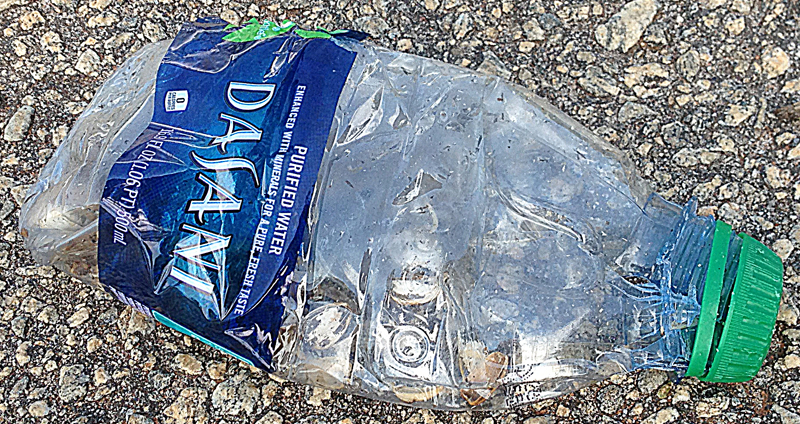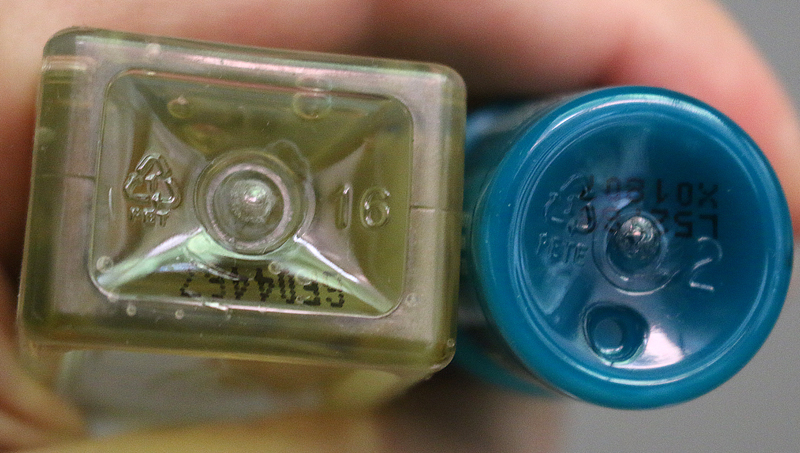Plastic tends to be a concern among environmentalists who fear that the artificial material — which is not indigenous to any natural setting on the planet but is found in many of the products we use every day — is slowly polluting the Earth, as millions of tons are generated and disposed annually…
Is There Any Hope For Plastic Recycling? Earth Day 2021

…but the fact that almost 35.7 million tons of plastic was produced in the United States alone in 2018 — according to the Environmental Protection Agency of the United States — should not be a problem. After all, plastic can be recycled, as indicated by that little triangle with the number inside of it at the bottom of bottles and other items which are manufactured as plastic. Simply toss it into the proper bin; and it will find a new life as a different plastic item and not simply be left somewhere to take centuries to finally decompose while leaching chemicals into the soil or water in the process…
…or so the public at large was led to believe by the major oil companies, as one investigative report accuses “big oil” of lying and betraying the public trust pertaining to the viability of recycling the now-ubiquitous material.
“Laura Leebrick, a manager at Rogue Disposal & Recycling in southern Oregon, is standing on the end of its landfill watching an avalanche of plastic trash pour out of a semitrailer: containers, bags, packaging, strawberry containers, yogurt cups”, according to this article by Laura Sullivan of National Public Radio — which is better known as NPR. “None of this plastic will be turned into new plastic things. All of it is buried.”
The problem is that recycling plastic may be friendly to the environment — but doing so is often more expensive than simply disposing of the items in the trash or burning it.
Take a look at the following chart which is included in the aforementioned report from the Environmental Protection Agency of the United States:
| Management Pathway | 1960 | 1970 | 1980 | 1990 | 2000 | 2005 | 2010 | 2015 | 2017 | 2018 |
|---|---|---|---|---|---|---|---|---|---|---|
| Generation | 390 | 2,900 | 6,830 | 17,130 | 25,550 | 29,380 | 31,400 | 34,480 | 35,410 | 35,680 |
| Recycled | – | – | 20 | 370 | 1,480 | 1,780 | 2,500 | 3,120 | 3,000 | 3,090 |
| Composted | – | – | – | – | – | – | – | – | – | – |
| Combustion with Energy Recovery | – | – | 140 | 2,980 | 4,120 | 4,330 | 4,530 | 5,330 | 5,590 | 5,620 |
| Landfilled | 390 | 2,900 | 6,670 | 13,780 | 19,950 | 23,270 | 24,370 | 26,030 | 26,820 | 26,970 |
Sources: Plastics information is from the American Chemistry Council and the National Association for PET Container Resources. A dash indicates data which is not available.
Of the 35,680,000 tons of plastic which was generated in the United States alone, greater than 75 percent — or 26,970,000 tons — was buried in landfills. Only 3,090,000 tons of plastic — which seems like a lot but is actually only slightly greater than 8.66 percent — was actually recycled; and those percentages remained fairly constant since 2015.
“The fact is, a huge amount of the plastic surrounding us isn’t recycled because it’s not really recyclable — and that means that it that it ends up in landfills, or burnt, or in the ocean where it breaks down into microplastics, gets eaten by fish, and can end up inside us,” according to John Oliver in this video from Last Week Tonight with John Oliver.
If that sounds familiar to you, that may be because you may have read this article about why soaps which contain microbeads are no longer available or this article at The Gate pertaining to the possibility that we ingest enough plastic to eat one credit card per week — a statement which was questioned and challenged by some readers of The Gate, as indicated by this comment by WR2 as one example:
Sorry, but there’s so much misinformation in this post. First off, there are no “garbage patches” in the oceans. I assume you are referring to the “garbage island” meme, which is a complete lie. If you go there you will see nothing. There is an increase in the ppm in that area of the ocean, but most of the particles are tiny.
Second, relying on one “study” is dubious at best, so I would bet my life that the real number of amount of plastic ingested is much lower. However, it doesn’t really matter, because it’s pretty much harmless. It passes right through your system. It is a non-problem. That should be obvious given how much plastic we supposedly consume and yet we are doing just fine thank you.
Finally, the majority of plastic entering the oceans comes from Asia. Specifically, China, Thailand and Vietnam. If you go to Thailand you will see this firsthand. We are not the problem. We don’t dump our garbage into the ocean. So what we do here makes zero difference.
To support that argument, WR2 cited this article by Alex Berezow of the American Council on Science and Health, which claims that eight rivers in Asia and two rivers in Africa cause approximately 90 percent of pollution in the oceans of the world which are caused by plastic. Assuming that that statistic is true, that means that the aforementioned numbers of the generation of plastic in the United States — as well as the remainder of North America, Europe, and Australia inclusive — is fewer than ten percent.
Furthermore, John Stossel — who has been an investigative reporter for decades — called out on the “tyranny” and “stupidity” of recycling with the following two videos:
Yes, Hope Does Exist For Recycling Plastic
Although recycling plastic does seem to help — even if at only slightly greater than 8.66 percent — some innovative thinking has led to one promising effort: paving roads and highways with plastic.
“A road running through Accra, Ghana’s capital, looks like any other blacktop. Yet what most drivers don’t realize is that the asphalt under them contains a slurry of used plastics — shredded and melted bags, bottles, and snack wraps — that otherwise were destined for a landfill”, according to this article written by Ann Parson of Yale School for the environment. “The impetus for many similar road projects underway in Ghana was an ambitious plan announced by President Akufo-Addo in 2018. It calls for Ghanaians to strive for a circular model, to recycle and reuse as much plastic waste as they produce each year — roughly 1.1 million tons — by 2030.”
At only approximately five percent of plastics which are recycled, Ghana — which is one of the 54 countries which comprise the continent of Africa — apparently has a worse percentage than the United States; and because only 23 percent of the entire road network in Ghana was paved as of January of 2019, paving roads with plastic that would otherwise find its way into a landfill or burnt would actually help towards solving two problems simultaneously.
I have driven on many unpaved roads in several countries in Africa. I intend to document my experience in Lesotho as an example in a future article. Having paved roads would obviously have been easier on which to drive.
Summary

Only approximately nine percent of the 350 million tons of plastic which humans produce each year is recycled — and the problem is that no tangible value can be realized by the average everyday man, woman, or child…
…but once a value is placed on used plastic or some other material which would otherwise be considered worthless, more people will be incentivized to repurpose it. One example is used cooking oil which was disposed by restaurants — until vehicles were manufactured which could use it as fuel; and diesel engines can supposedly operate on used vegetable oil — but operating motor vehicles with used vegetable oil may not be legal, according to this article from the Environmental Protection Agency of the United States:
Raw vegetable oil or recycled greases (also called waste cooking oil) that have not been processed into esters are not biodiesel, and are not registered by EPA for legal use in motor vehicles. Because of the potential for increased emissions from a vehicle, it is considered unlawful tampering to convert a vehicle designed for diesel fuel to operate on waste cooking oil without EPA certification. To date, EPA has not certified any such conversions. These conversions may also violate the terms of the vehicle warranty.
Likewise, guests at hotel and resort properties who prefer using single use bottles of toiletries, straws, and other items manufactured out of plastic which are intended to be used only once or a few times may not see the value proposition of using bulk dispensers of products instead in order to reduce the footprint of pollution which is caused by plastic.
One of the 37 bills which Gavin Newsom signed into law as of Wednesday, October 9, 2019 was a bill to ban personal care products in the form of miniature plastic toiletry bottles — which contain fewer than 12 ounces of liquid product — from lodging establishments in California to become effective as of Sunday, January 1, 2023. Only eight days earlier, the state of New York announced the intent in seeking to enact a similar law.
As I wrote in this article last year, my preference is to have the choice of whether or not I want the small containers of toiletries — reasons which both support and oppose them are listed in this article — but I am likely in the minority regarding that opinion…

…and while I am not panicking about “global warming” and fearing the catastrophic effects to the environment which some people claim will occur, I believe we should do everything we can — within reason and within our power — to control the amount of pollution caused by plastic. For example, I prefer to purchase small souvenirs from other countries rather than souvenirs which are stamped out by some production line in some faraway country which offers little value, in my opinion — which was one of the three reasons which I did not like the souq at Muttrah Corniche in Muscat in Oman. You can find out nine other tips pertaining to purchasing souvenirs in this article.

I also attempt to repurpose items which may otherwise wind up in a landfill or burnt. For example, I use clean jugs for drinking water to reclaim water which would otherwise be wasted.
Other articles pertaining to plastic waste and recycling include:
- Earth Day 2020: Should Single Use Plastics Be Eliminated at Hotels Worldwide After All? 2019 Novel Coronavirus Pandemic
- Accor to Eliminate Single Use Plastics Worldwide in All Hotels By 2022
- Hyatt Hotels Corporation to Replace Smaller Plastic Amenities Packages and Water Bottles Worldwide
- Ban of Single Use Plastic Toiletry Bottles at Hotels to Become Law in California
- Bulk Amenities to Replace Bathroom Miniature Packages Across All Brands of Marriott International, Incorporated
- Bulk Amenities to Replace Bathroom Miniature Packages Across All Brands of InterContinental Hotels Group
- Miniature Toiletry Bottles in Hotels: What Really Should Be Done
- Wall Mounted Dispensers Versus Small Bottles of Amenities in Hotels
- Sale of Single Use Disposable Plastic Water Bottles Banned by San Francisco International Airport
- We Ingest Enough Plastic to Eat One Credit Card Per Week
- Single Use Plastic Toiletry Bottles at Hotels to Become Illegal in New York?
- Single Use Plastic Toiletry Bottles at Hotels to Become Illegal in California?
- Stupid Tip of the Day: Use Recycling Bins Whenever Possible
- Earth Day 2019: Clean the World by Recycling Used Soap and Plastic Bottles
- Earth Day 2018: Clean the World by Recycling Used Soap and Plastic Bottles
- Earth Day 2017 — and What Hilton is Doing to Help Save the Environment
- …and the Overpackaging of Hotel Amenities Award Goes To…
- Microbeads: Could Your Toiletries Be Damaging the Environment?
All photographs ©2015, ©2016, ©2017, and ©2019 by Brian Cohen.

